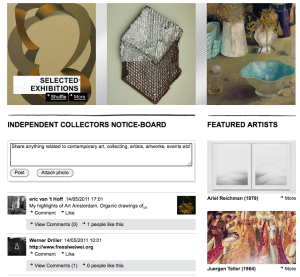In this last post about the digitalization of the art world, we wanted to focus on the lack of experience in the virtual art fairs.
If you are an art collector, artist or just an art lover in general, going to art fairs might often leave you with a mixed feeling. The venue of a trade fair leaves its stamp on experiencing the works, which don’t always get the space and the light they need… and the food is never as good as what you get served in restaurants from gallery districts of London, Berlin or Paris. But all this is often compensated by the joy of seeing new work from one of your favorite artists, by having an inspiring conversation with a gallery owner or by running into fellow collectors. If a virtual art fair wants to compete with the vibrant atmosphere of its real-life counterpart (including the experience of a nice city trip), it needs to be more than just a website.
Most virtual art fairs have failed until today because they didn’t build upon a lively online community. The Art Amsterdam Online was hosted on Open Art Collection, the VIP Art Fair was a new platform. Both initiatives couldn’t benefit from an existing online community. We think that initiatives such as Independent Collectors or Welcome to Company who are today creating a community of art lovers, have more potential to become a market place later.
 Art lovers are most of the time visual people. They appreciate nice design, good use of colors and fonts. Experiencing the interface of The Open Art Collection, we felt like we were forced using an accountant software from the ’90s. Why not experiment with html5, with big visuals, with light boxes? (Independent collectors platform uses e.g. black and white for all data and information, the only elements in color being the art works uploaded by the members. A very smart way in giving the more importance to the main subject – the artwork.)
Art lovers are most of the time visual people. They appreciate nice design, good use of colors and fonts. Experiencing the interface of The Open Art Collection, we felt like we were forced using an accountant software from the ’90s. Why not experiment with html5, with big visuals, with light boxes? (Independent collectors platform uses e.g. black and white for all data and information, the only elements in color being the art works uploaded by the members. A very smart way in giving the more importance to the main subject – the artwork.)
Art fairs are part of the art market. The visual impression, the concept behind and the price of a particular piece offered are of course the main elements in game, but the cultural value of a work, created by a mixture of the artist’s reputation, the context of the work within the artists’ output, the reputation of the gallery that represents him etc. is at least as important for every serious collector. A smart virtual art fair platform could take advantage of the possibilities of the internet and provide a collector with trustworthy information one doesn’t always have at hand on a fair.
As a last element, we would like to add that maybe organizing a virtual art fair is not the right way to approach the art business. Developing digital tools and services might be a smarter way in getting the attention of the collector. Think of a flipbook type of ipad app where you receive automatically all the shows of your favorite galleries, each artist links to a series of pictures but also to information about recent exhibitions, the price level of his work, … you can save the works you like in your virtual watchlist… and maybe you can even make an appointment with the gallery owner to discuss the work over Skype or in real life.
There is definitely a future for going digital in the art world. The winners will have integrated the passion for art with the strength of the digital medium. And they are probably already working on it right now!
